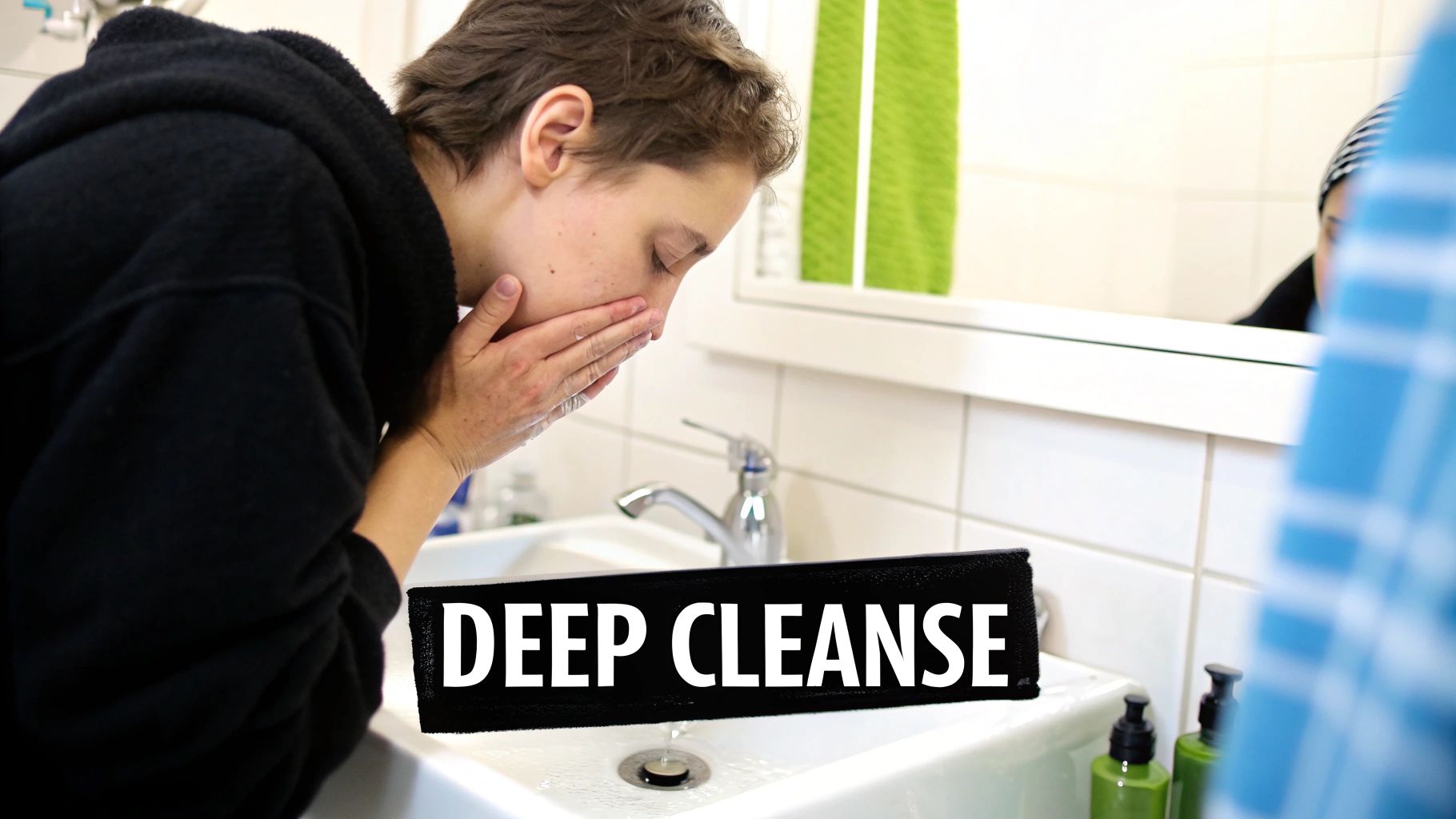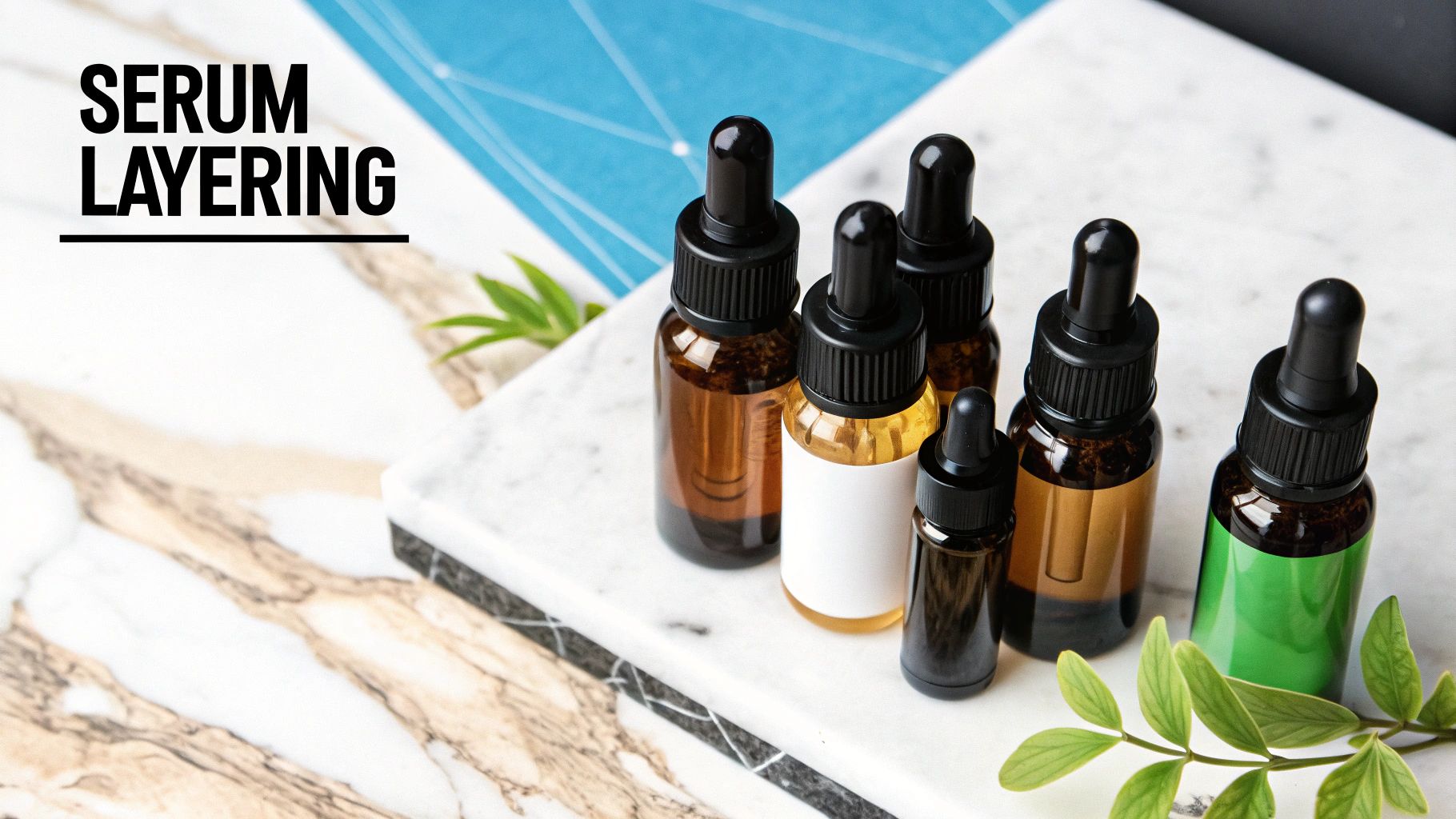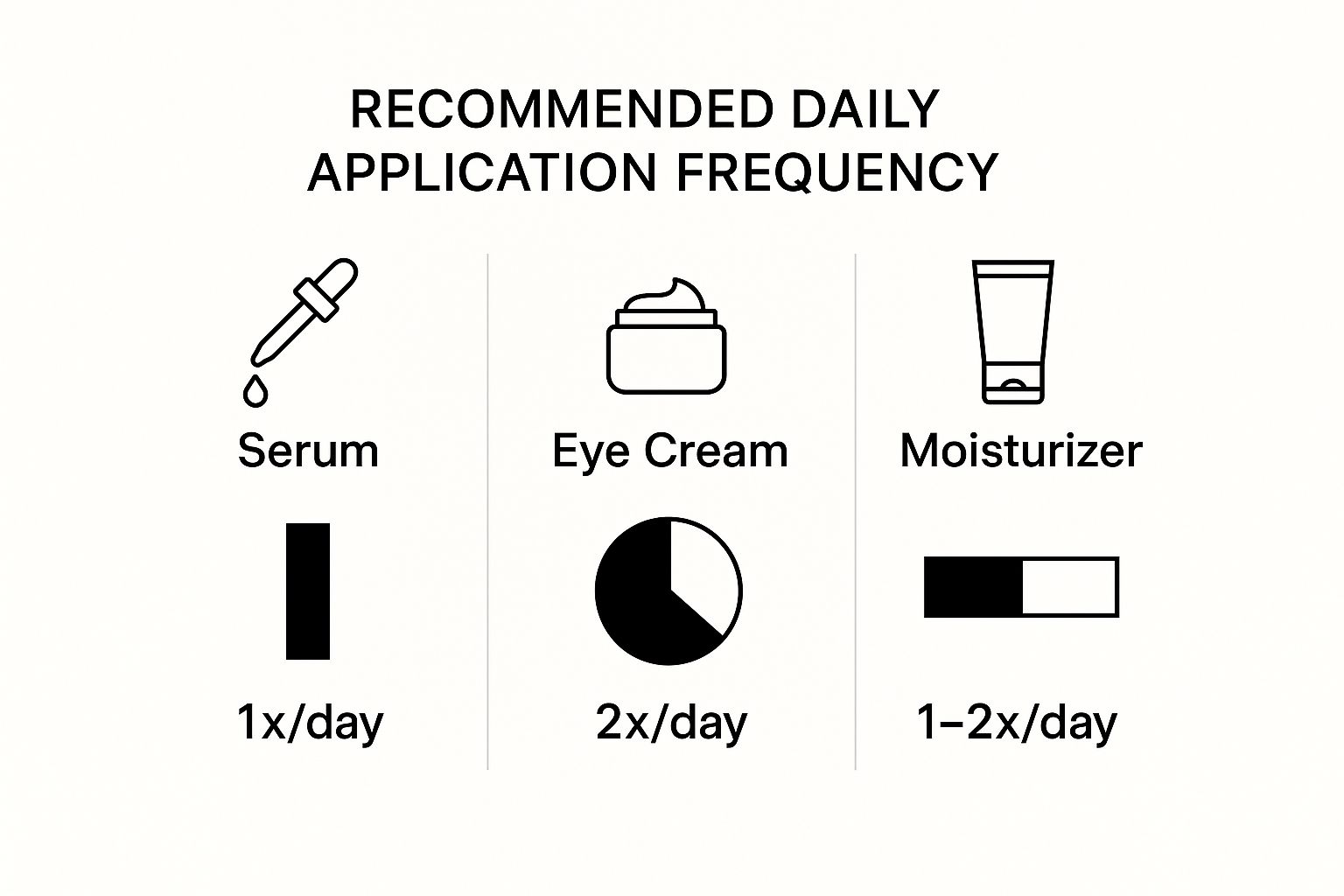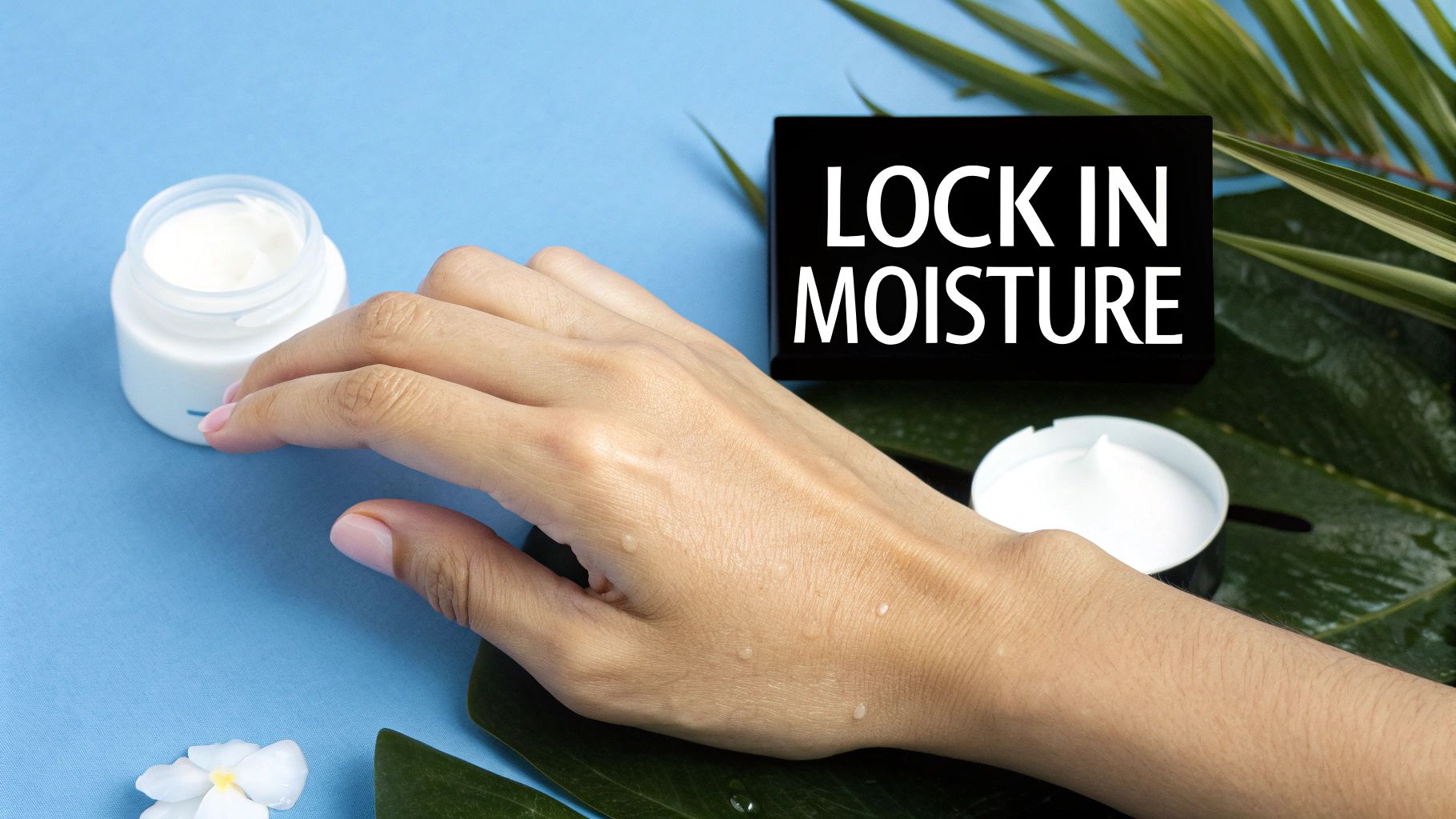Jan Elvis
29.09.2025

Jan Elvis
29.09.2025
Ever wondered if the order you apply your skincare products actually makes a difference? The short answer is yes—a huge one. The golden rule I always share with guys just starting out is to go from thin to thick. Think of it like this: you want to apply your most lightweight, watery products first and finish with the heaviest creams.
This isn't just some arbitrary rule. It's all about making sure each product can actually do its job.

Before you even open a bottle, let's get into the why. The order you layer your products is a strategy, pure and simple. It's designed to get the most bang for your buck and deliver the results you're paying for.
Slapping a watery serum on top of a thick moisturizer is like trying to water a plant through a sheet of plastic. It just won't work. The moisturizer forms a seal, and those powerful active ingredients in your serum can't get through to your skin. It's a waste of time and good product.
The whole point of a routine is to let each product work its magic. For powerhouse ingredients like Vitamin C or retinoids to be effective, they need to actually sink into your skin. By applying them directly to clean skin, you give them a clear path to get to work without anything blocking their way.
It's a concept that has caught on in a big way. The global skincare market hit a staggering USD 115.65 billion in 2024, which shows that people are getting serious about optimizing their routines. We're not just buying products anymore; we're learning how to use them effectively. For more on these trends, you can dive into the market data on fortunebusinessinsights.com.
Getting the order wrong doesn't just make your products less effective; it can also cause real-world problems. Ever had your products ball up into little flakes on your face? That’s called pilling, and it often happens when you layer a water-based product over an oil-based one. It's a frustrating mess that's easily avoided.
Proper layering isn’t just about following steps; it’s about creating a synergistic system where each product prepares the skin for the next, ultimately leading to better, more consistent results.
Following the right sequence ensures everything applies smoothly, feels great, and actually works.
To make things even simpler, here's a quick cheat sheet for the core steps in your morning and evening routines.
This table breaks down the essential steps to follow every morning and night. While you can add treatments and other extras, these are the non-negotiables for healthy skin.
| Step | Morning Routine (AM) | Evening Routine (PM) |
|---|---|---|
| 1. Cleanse | Essential to start with a fresh face. | Crucial for removing the day's dirt and grime. |
| 2. Tone | Helps balance skin pH and preps for other products. | Can help remove any last traces of impurities. |
| 3. Treat | Apply targeted serums (like Vitamin C). | Apply treatments like retinoids or exfoliants. |
| 4. Moisturize | Hydrates and protects the skin barrier. | Locks in moisture and aids in overnight repair. |
| 5. Protect | Never skip sunscreen! | Not needed. |
Think of this table as your foundational guide. Once you nail these basics, you can start customizing your routine with more advanced steps.
Your morning routine is all about defense. Think of it as putting on armor before you head out for the day to face down pollution, UV rays, and everything else the world throws at you. The goal here is pure protection, setting your skin up for success. We'll save the heavy-duty repair work for the evening.
First things first, you have to cleanse. This isn't just about splashing some water on your face. You're clearing away the oil and sweat that built up overnight, plus any remnants of last night's products. This gives you a clean slate so everything you apply next can actually do its job. A gentle cleanser is what you want—something that cleans without stripping your skin and leaving it feeling tight.
With a clean face, it’s time for a serum. For the morning, nothing beats a good Vitamin C serum. This stuff is a powerhouse antioxidant. It works to neutralize damaging free radicals from sunlight and city grime, giving you an extra layer of defense that works in tandem with your sunscreen. Just pat a few drops on and give it a minute to soak in.
Once the serum has settled, it's time to moisturize. During the day, you want something lightweight. You're not looking for a heavy, greasy cream; you need a moisturizer that locks in the serum, keeps your skin hydrated all day, and doesn't make you look shiny. This is a critical step for keeping your skin barrier strong and healthy.
The right moisturizer can change the game, especially when the weather turns. If you need some help finding the right one, we've got a whole guide on picking the best face moisturizer for winter that's full of practical advice.
It's clear guys are catching on to this multi-step approach. The U.S. skincare market was worth almost USD 24 billion in 2023, and more and more people are using routines with at least three products. With 247 million units of facial cleansers sold last year alone, the message is out: a clean base is fundamental for the proper skin care order of application. You can dig into more of this data over at Statista.com.
Let’s be real: if you skip sunscreen, you might as well skip the rest of your routine. It's the one step you absolutely cannot miss.
And that brings us to the final, most important layer: sun protection. A broad-spectrum sunscreen with at least SPF 30 is non-negotiable. Every. Single. Day. Rain or shine. This is your number one tool against wrinkles, sunspots, and skin cancer. A quick tip: let your moisturizer fully absorb for a minute or two before you put on your sunscreen. Apply it gently instead of rubbing it in aggressively—this helps it form an even, protective shield and prevents that annoying pilling.

Think of your nighttime routine as your skin’s personal pit crew. While you're asleep, your body is in full repair mode, and your skincare should be right there to support the process. This is the time for deep hydration and targeted treatments, where you can really bring out the heavy hitters to tackle whatever is bugging your skin.
Before any of that can happen, though, you have to get your face properly clean. Your skin has been a magnet for sweat, sunscreen, and environmental gunk all day. A quick wash just won't cut it. That's why I'm a big advocate for double cleansing. You start with an oil-based cleanser to dissolve all the oily stuff (like sunscreen and sebum), then follow up with a regular water-based cleanser to wash it all away. This two-step process leaves your skin genuinely clean and prepped for what comes next.
Once your face is a clean canvas, it’s time for the real work to begin. Your evening routine is the perfect opportunity to use potent active ingredients like retinoids or alpha-hydroxy acids (AHAs), which are best used when you’re out of the sun. These ingredients are champions at speeding up cell turnover, helping to smooth out fine lines and fade stubborn dark spots.
But hold on—don't just throw everything at your face at once. That's a fast track to irritation. A much smarter approach is skin cycling, a method where you rotate your active ingredients throughout the week. It prevents you from overwhelming your skin.
A simple cycle might look like this:
This strategy lets your skin reap all the rewards of the actives without compromising its protective barrier. You’re playing the long game here.
The most effective nighttime routine is a consistent one. It's about giving your skin the tools it needs to regenerate while you rest, setting you up for a fresh start the next morning.
Finally, you need to seal the deal. After your treatment serum has had a minute or two to sink in, it's time to layer on your moisturizer. The last step in your evening skin care order of application should always be a solid night cream. A good one provides intense hydration and creates a protective layer, preventing water loss while you sleep. Using a product designed for overnight recovery, like our revitalizing night cream, can seriously amplify the repair process so you wake up looking and feeling refreshed.
This is where you get to personalize your routine. Serums and treatments are the heavy hitters, packed with potent ingredients to target your specific skin concerns. But to get the most out of them, the skin care order of application is everything. It sounds complicated, but it's actually pretty straightforward.
The golden rule? Go from thin to thick. Always.
Your lightest, most watery serums need to go on right after you cleanse or tone. Think of it this way: if you slather on a thick cream first, it creates a barrier. That lightweight hyaluronic acid serum you want to drench your skin in? It’s not getting through.
This is the one principle you absolutely have to remember. Water-based serums always, always go on before oil-based ones. Apply your watery serum, give it a solid minute to sink in, and then you can move on to the next step.
That short pause is crucial. It stops products from pilling up on your skin and lets each ingredient get to work without getting in the way of the others.
Expert Tip: Don't rush it. Letting each layer absorb for 60 seconds makes a huge difference in how well the products perform and how your skin feels afterward.
Of course, with so many active ingredients out there, it can be tough to remember what plays nicely with what. This is a huge reason the Skin Care App Market was valued at USD 24.1 billion in 2023—these apps offer personalized guides on what to use and when. You can find more details on this trend over at Verified Market Research.
The frequency of application matters, too. Some products are for daily use, while others are best used a few times a week.

As you can see, things like eye cream are fine to use twice a day, but powerful serums are often best used just once to avoid irritating your skin. If you’re looking to add some great formulas to your lineup, our guide to natural skin care products for men is a good place to start.
Navigating which active ingredients to mix and match can feel like a chemistry class. Some ingredients are powerhouse duos, while others can cancel each other out or cause irritation when combined.
Here’s a simple cheat sheet to help you get it right.
| Ingredient | Best Time to Apply | Pairs Well With | Avoid Mixing With |
|---|---|---|---|
| Vitamin C | AM | Vitamin E, Ferulic Acid, SPF | Retinoids, AHA/BHA (at same time) |
| Retinoids | PM | Hyaluronic Acid, Niacinamide | Vitamin C, Benzoyl Peroxide, AHA/BHA |
| AHA/BHA | PM (or alternate days) | Hyaluronic Acid, Moisturizers | Retinoids, Vitamin C, other exfoliants |
| Niacinamide | AM/PM | Almost everything (Retinoids, Vitamin C) | High-concentration Vitamin C (sometimes) |
| Hyaluronic Acid | AM/PM | All ingredients | (Generally safe with everything) |
Think of this table as a starting point. Your skin is unique, so always patch-test new combinations and pay attention to how your skin reacts. The goal is to build a routine that delivers results without causing redness or irritation.

So, you've got the products. You understand the steps. But even the best routine can fall flat if you're making a few common application mistakes. It's often the small details that make the biggest difference between so-so results and truly great skin.
Let's start with a classic one: putting serums on bone-dry skin. A lot of active ingredients, especially popular hydrators like hyaluronic acid, are designed to grab onto water. Applying them to slightly damp skin gives them the moisture they need to pull into your skin, supercharging their effect.
Another major fumble I see all the time is rushing through the layers. If you're slathering on your moisturizer the second after your serum, the products don't have a chance to do their jobs. They just mix together on the surface, often causing that annoying "pilling" effect where the products ball up.
Here’s a simple fix: Just wait. Give each layer about 60 seconds to sink in before you move on. This little bit of patience allows each product to penetrate properly and work without getting diluted or blocked by the next one.
Think your face ends at your jawline? Think again. Your neck and chest are getting just as much sun and environmental exposure as your face, and they'll show signs of aging just as fast—if not faster.
Nailing these small adjustments ensures you’re getting every bit of value out of the products you've invested in.
Getting the basic order of your skincare routine down is a huge step, but I know from experience that specific questions always come up. Let's get into the details and clear up some of the most common points of confusion.
This is a great question. You don’t want to rush it, as that can cause products to ball up on your skin (a frustrating thing called “pilling”) and make them less effective.
As a solid rule of thumb, give each layer about 60 seconds to sink in. This gives thinner products like your serum a chance to fully absorb before you go in with a heavier moisturizer or oil.
The order for these specialty products trips a lot of people up. Here’s the simplest way to think about it:
Think of it like this: eye creams need direct access to that delicate skin, while spot treatments are the final, concentrated attack on problem areas.
Honestly, this really comes down to your specific skin type. If your skin is on the drier or more sensitive side, a simple splash of lukewarm water might be all you need to feel refreshed without stripping away essential moisture.
However, if you have oily or acne-prone skin, I’d strongly recommend a gentle cleanse in the morning. This clears away the oil and sweat that built up overnight, giving you a clean base for your daytime products like vitamin C and sunscreen. The best advice is always to listen to what your skin is telling you.
Ready to build a routine that truly works for you? Main Character has everything you need to get started. Explore our collection and build your confidence at https://www.dontlooktrash.com.